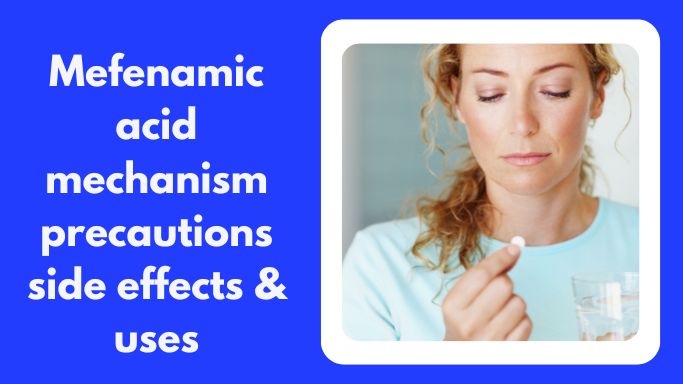Mefenamic acid mechanism precautions side effects & uses let us discuss one of the well known drug methanomic acid. What is this drug? Methanomic acid. Methanomic acid is one of the non steroidal antiinflammatory drug commonly known as Anocide.
And this methanomic acid is an anthrolic acid derivative classified as Anocide, which is used to control mild to moderate pain. And this methanomic acid is particularly used to control the pain in conditions like Dysmenoria. So this drug can be used to control the menstrual. Pain during the menstruation or premenstrual pain can be controlled by maphinic acid. And many of the times this drug can be combined with end.
The drug Dicyclomine, which is an antispasmodic acid. Dicyclomin is an anticonergic agent which produce the relaxation of GS smooth muscle. So this drug can be combined with methanomic acid which controls the pain during the menstruation. This methanomic acid should not be used in the children less than 14 years. So this drug is only indicated in the adults and adolescents with age greater than 14 years.
Read More: HbA1c test Advantages & limitations
Within the children the safety is not completely established. So use of methanomic acid in the children less than 14 years is not recommended. But still methanomic acid is available as an antipyrotic agent at a low dose around 50 mg as an oral suspension to control the fever in the children. But as analysis this drug is not recommended in the children less than 14 years. Now it is a chemical agent of this drug.
So this is a structure of methanomic acid. Here we can easily observe, it is having the carboxylic acid attached to inline. So it is a anthroinic acid derivative. Now we can start the numbering from the carboxylic acid. So this is one and this is two.
So simply it is a benjoic acid derivative. And at the second portion is having a side chain. This side chain is nothing but the eneline ring. So we can give the numbering here. This is one, two and three.
So simply this enliven ring is hang the methyl groups at second and third portion. Therefore we can write this as two three dimethyl enelino. That is a simple name of methanomic acid. So methanomic acid is two dash two three dimethyl INO benjoic acid. And Methanic acid can also be considered as phenyl anthrolic acid with methyl substitution.
That’s why it is hang the name as methanomic acid. Now let us see the precautions of this drug. This drug acts as a non steroidal antiinflammatory drug. Thereby it inhibits the synthesis of prostaglandins. Aredonic acid is one of the important precursor which is going to be converted into prostaglandins like PGE Two and PGI Two.
And this step is mediated by Cox One enzyme. Cox one enzyme is a constitutive enzyme which is always present and responsible for physiological functions by synthesizing the prostaglandins. Now these prostaglandins PGE Two and PGI Two play an important role within the stomach. These prostaglandins can reduce the release of gastric acid. Thereby acid secretion is somewhat reduced by protective prostaglandins.
Now, maphinic acid is a nonselectocox inhibitor. That means this drug can block both Cox One enzyme as well as Cox Two enzyme. By inhibiting the Cox Two enzyme, it can reduce the pain and inflammation. But at the same time, this drug can also inhibit the Cox One enzyme.
thereby inhibits the sense of protective prostaglandins. When these prostaglandins are not synthesized, the gastric acid is excessively secreted, resulting in few of the gastrointestinal side effects, such as increased ulceration, increased perforation of gastric, smooth muscle, and if it is untreated at very high dose, methanomic acid may also produce gastrointestinal bleeding, which is commonly observed with more potent non sterile antiinflammatory drugs.
Aspirin is one of the drug which can produce gastrointestinal bleeding. So if aspirin is combined with methanomic acid, it further increase the risk of gastric bleeding. That’s why this methanomic acid should be carefully used, preferably at a low dose, in order to reduce the gastrointestinal side effects. Similarly, Cogs One play an important role in the sense of many of the prostaglandins at other locations. Again, the aridonic acid can be converted into prostaglandins like PGI Two.
This PGI Two is also called as prostacycline. This mediator can act on the blood vessels which are expressed with IP receptors. These IP receptors are the receptors for prostaglandin I Two. Now PGI Two can act on these IP receptors, which results in the vasodilation. This vasodilation prevents the clot formation as well as platelet aggregation.
So prostaglandin I Two play an important protective role by reducing the platelet aggregation. Now again, maphonic acid is a non selective Cox inhibitor. It can inhibit the Cox one in Gem activity. So the synthesis of PGI Two is going to be reduced, which results in lack of vasodilation, leading to increased vasoconstriction of blood vessels. And with increased vasoconstriction and narrowing of blood vessels, the platelet may come nearer, leading to plated aggregation and clot formation.
So the risk of thrombotic events are more pronounced with use of methanomic acid, particularly for long term. So, just like other anocytes, methanomic acid can increase the risk of stroke as well as myocardial infarction. So in those patients with preexisting cardiovascular abnormalities or thrombotic events such as stroke and myocardial infarction.
or atherosclerosis in such patients, methanomic acid should be carefully used as it further increase the risk of stroke and cardiac damage. Another important role of prostaglandins is on the renal system. Prostaglandins like PGI Two and PGE Two can increase the renal functionality, so they can act on their corresponding receptors.
Thereby they can increase the glomerul filtration and rate of excretion is going to be increased, which protects the functionality of the renal system. Now, maphymic acid inhibits the sense of these prostaglandins, thereby it reduces the action of these prostaglandins on the renal system. As the acute of prostaglandins is reduced.
the renal functionality is also reduced, which results in the decreased glomerul filtration rate. So, as GFR is reduced excretion is also reduced which may result in retention of few of the minerals, particularly potassium is more retained within the body resulting in hyperkalemia. This hyperkalemia may lead to cardiovascular complications.
So that’s why maphinic acid should be carefully used in those patients with decreased renal functionality or renal failure. And the important precaution is that maphinic acid can produce some anaphylactic reactions.
It can also produce some hypersensitivity resulting in skin rashes, exfoliative, skin disorders even it can produce some difficulty in breathing Dyspnea. And even phototoxicity may be produced by maphrenic acid. So if any of these symptoms are observed in the patient then immediately the use of maphinic acid should be stopped.
Similarly, maphinic acid can also increase the hepatotoxity, it can increase the liver enzymes and it may prescribe. Few of the symptoms such as nausea, fatigue, diarrhea and symptoms like Jaundice can be produced by long term use of maphremic acid. Now let us see how this drug acts. On the nonceptive neurons, different types of receptors are present. For instance, for instance, EP receptors and B Two receptors are present.
The EP receptors are the receptors for PGE Two. Now PGE Two can act on these EP receptors which results in the activation of protein kinase. Similarly, B Two receptors are activated by brady Kynee. The brady kinain can act on B Two receptors resulting in the activation of protein kinase C. Both of these phosphorylating enzymes may result in depolarization and induction of pain sensation.
Here prostaglandins can also sensitize the bradykinine receptors, thereby they can increase the pain sensation. Now, maphinic acid can inhibit the sense of prostaglandins. Thereby it inhibits the pain transmission and pain sensation. Phospholipase A Two is one of the cleavage enzyme which can act on the phospholipid such that it can release one of the important mediator that is aridonic acid. This aregdonic acid is a C 20 fatty acid which may be converted by Cox enzyme to various types of mediators such as PGG Two and PGH Two which are the cyclic endoper oxides.
Again, they are cured by Cox enzyme and they are converted into various prostaglandins such as PGE Two, PGI Two and Thromboxen A Two. The PGE Two and PGI Two particularly increase the pain sensation which is going to be blocked by maphanic acid. Now, maphinic acid inhibits the Cox NGM activity so that it can inhibit the synthesis of prostaglandins. By this it can reduce the pain sensation and control the menstrual pain in the conditions like Dysmenoria. Now let us see the side effects of this drug.




